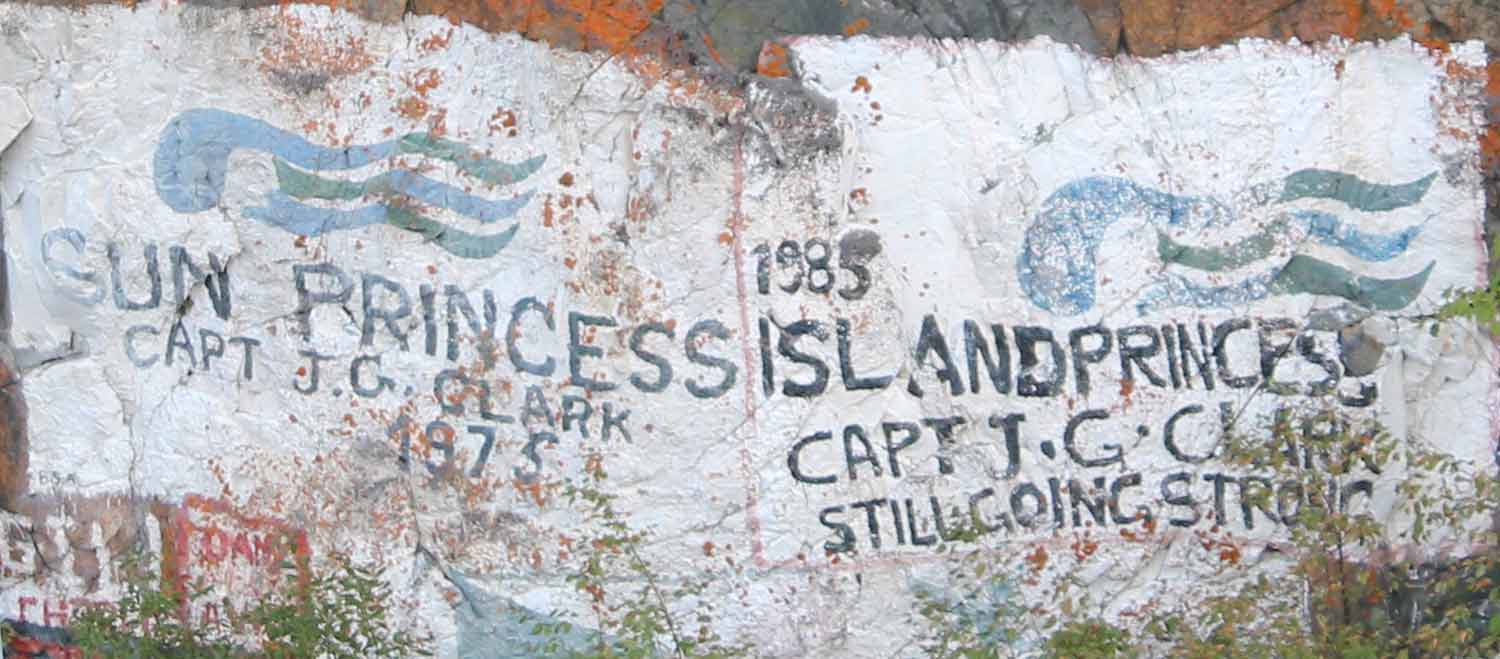After a morning learning about the Klondike gold rush and the (mostly) men who slogged their way up the mountains to get there through White Pass, we were dropped on the main street of Skagway to wander.
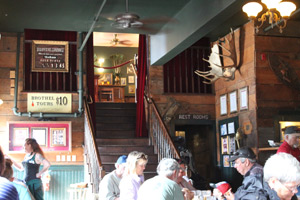 We started by having lunch in the Red Onion Saloon. There seems to be a lot of Red in names in the Panhandle. Not sure why, but it is what it is. The Red Onion is located in a historic building in the centre of town. It claims to have been a saloon and bordello during the gold rush, and it tries to recreate that atmosphere today. The food was tasty and the staff were fun. The girls (using currently politically incorrect term here, but in a correct historical way) were scantily clad (1890s style scanty) and mingled with the customers. One even stood at the open front door and advertised tours of the brothel – er – bordello museum upstairs. A fun place to spend a leisurely lunch hour, with standard lunch items, tarted up with bordello type names (Streetwalker Salmon Dip was excellent.)
We started by having lunch in the Red Onion Saloon. There seems to be a lot of Red in names in the Panhandle. Not sure why, but it is what it is. The Red Onion is located in a historic building in the centre of town. It claims to have been a saloon and bordello during the gold rush, and it tries to recreate that atmosphere today. The food was tasty and the staff were fun. The girls (using currently politically incorrect term here, but in a correct historical way) were scantily clad (1890s style scanty) and mingled with the customers. One even stood at the open front door and advertised tours of the brothel – er – bordello museum upstairs. A fun place to spend a leisurely lunch hour, with standard lunch items, tarted up with bordello type names (Streetwalker Salmon Dip was excellent.)
Having had lunch in a historic restaurant, we moved on to the national park headquarters for a look at their info and to grab a map of the historic district.
 Skagway Historic district is part of the Klondike Gold Rush National Historic Park. The park also includes the Chilkoot Trail out of Dyea (at the head of the Lynn Canal). The Skagway historic district is a combination of historic site and private buildings. The National Park maintains over 20 of the buildings in the area. Others are privately owned, or belong to one or other levels of government.
Skagway Historic district is part of the Klondike Gold Rush National Historic Park. The park also includes the Chilkoot Trail out of Dyea (at the head of the Lynn Canal). The Skagway historic district is a combination of historic site and private buildings. The National Park maintains over 20 of the buildings in the area. Others are privately owned, or belong to one or other levels of government.
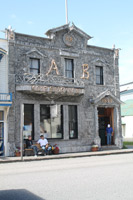 Skagway was a wooden town, but it never suffered a catastrophic fire, which means that none of the buildings had to be recreated, just restored to their 1898 appearance. After restoration the Parks Service leases the buildings back to private operators, so as in any old building, the insides are converted to modern use so the shops inside the buildings are mostly quite modern.
Skagway was a wooden town, but it never suffered a catastrophic fire, which means that none of the buildings had to be recreated, just restored to their 1898 appearance. After restoration the Parks Service leases the buildings back to private operators, so as in any old building, the insides are converted to modern use so the shops inside the buildings are mostly quite modern.
From there we wandered along the main street, taking in the A & B building – made entirely of driftwood, then stopped at the Moore House, a historic building that has been converted into a museum that helps explain some of the history of Skagway.
 The Moore house was owned by a Captain Moore who settled in Skagway in the 1880s. The Klondike Gold Rush part of a continuing cycle of gold rushes that had occurred up and down the West Coast throughout the second half of the 19th century. Moore thought there was potential for gold in the area, so he laid claim to 160 acres smack in the middle of modern Skagway and called the area Mooresville. He surveyed the White Pass route to the Klondike after being guided through it by a native known as Skookum Jim Mason, then set about creating a town around the natural harbout. When gold was discovered in the Klondike, Moore thought he’d found the motherlode himself, because he figured he’d control access to the gold fields and make a pile of money doing it. Alas, as the number of prospectors swelled, Mooreville became a tent city. The Stampeders renamed the town Skagway, and made their own land claims. In January 1898 a survey was begun, which Moore saw the survey saw as a threat and protested. He was right – the survey reduced his original claim to 64 acres – almost 2/3rds of the grant was lost.
The Moore house was owned by a Captain Moore who settled in Skagway in the 1880s. The Klondike Gold Rush part of a continuing cycle of gold rushes that had occurred up and down the West Coast throughout the second half of the 19th century. Moore thought there was potential for gold in the area, so he laid claim to 160 acres smack in the middle of modern Skagway and called the area Mooresville. He surveyed the White Pass route to the Klondike after being guided through it by a native known as Skookum Jim Mason, then set about creating a town around the natural harbout. When gold was discovered in the Klondike, Moore thought he’d found the motherlode himself, because he figured he’d control access to the gold fields and make a pile of money doing it. Alas, as the number of prospectors swelled, Mooreville became a tent city. The Stampeders renamed the town Skagway, and made their own land claims. In January 1898 a survey was begun, which Moore saw the survey saw as a threat and protested. He was right – the survey reduced his original claim to 64 acres – almost 2/3rds of the grant was lost.
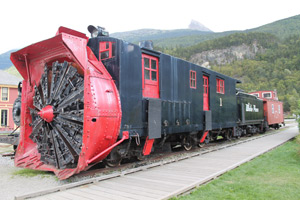 From the Moore House we returned to the main street and shopped our way back toward the harbour. The route took us past the White Pass and Yukon Route Railway Depot and train yard. The railroad was built to move people to the Klondike for the gold rush and now carries tourists from the cruise ships on day excusions. It’s located down on the edge of town, on flat land near the harbour – as you would expect it to be, since it is designed to take people arriving in town up to the gold fields. Snow can be deep and heavy on the tracks of this railroad so they needed a really big snowplow to clear it! The one in the picture was clearing snow from the beginning of the railroad in the late 1890s.
From the Moore House we returned to the main street and shopped our way back toward the harbour. The route took us past the White Pass and Yukon Route Railway Depot and train yard. The railroad was built to move people to the Klondike for the gold rush and now carries tourists from the cruise ships on day excusions. It’s located down on the edge of town, on flat land near the harbour – as you would expect it to be, since it is designed to take people arriving in town up to the gold fields. Snow can be deep and heavy on the tracks of this railroad so they needed a really big snowplow to clear it! The one in the picture was clearing snow from the beginning of the railroad in the late 1890s.
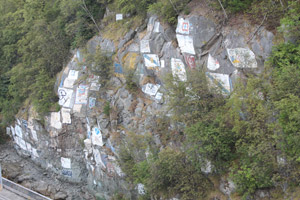 When we left the ship in the morning, the dock was a hive of activity. Now, at the end of the day, it was quiet and we had time to view the Railroad Dock wall. This isn’t really a wall, but the exposed side of a mountain. There’s a tradition, since the late 1920s (1928) though, that ships that dock in Skagway for the first time paint a logo and their name, and the ship captain’s name, on the wall as a memento. If you are docked at the Railroad pier, you can read the names from the cruise ship. Signs are never painted over, so some are faded, others bright, and different eras are jumbled together. A lot of ships dock in Skagway!
When we left the ship in the morning, the dock was a hive of activity. Now, at the end of the day, it was quiet and we had time to view the Railroad Dock wall. This isn’t really a wall, but the exposed side of a mountain. There’s a tradition, since the late 1920s (1928) though, that ships that dock in Skagway for the first time paint a logo and their name, and the ship captain’s name, on the wall as a memento. If you are docked at the Railroad pier, you can read the names from the cruise ship. Signs are never painted over, so some are faded, others bright, and different eras are jumbled together. A lot of ships dock in Skagway!
